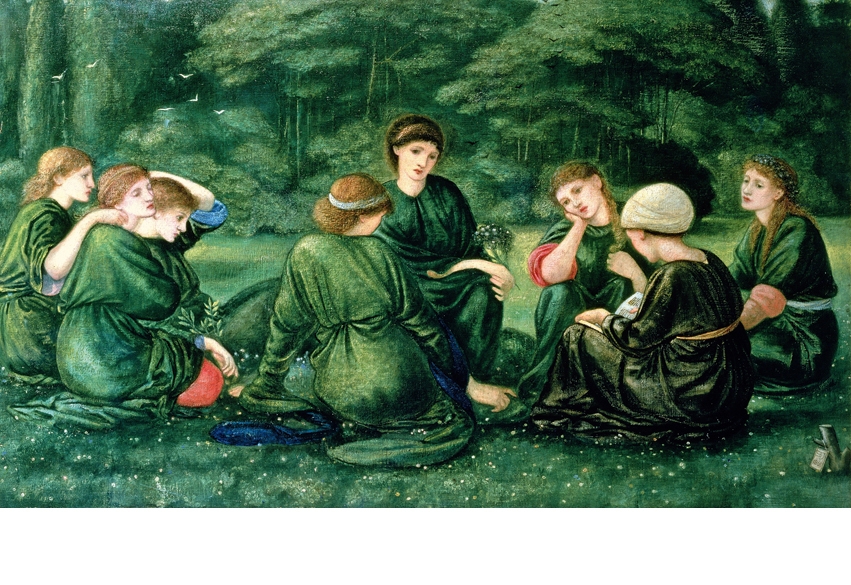Edward Burne-Jones was the archetypal literary-minded Victorian. Born in 1833, the son of a Birmingham picture-framer and gilder, he developed a taste for the Romantic poets while at school. Then, whilst an undergraduate at Oxford, he found a lifelong friend in William Morris. The university was supposed to be their route towards holy orders, but together they converted to the religion of art for art’s sake. Another student friend, Archibald MacLaren, gave Burne-Jones his first artistic break by asking him to provide illustrations for a collection of stories called The Fairy Family.
Why did the Victorians spend so much time away with the fairies? Though Fiona MacCarthy’s subtitle is ‘Edward Burne-Jones and the Victorian Imagination,’ she sticks closely to the traditional cradle-to-grave narrative and subject-centred focus of orthodox biography, offering little in the way of wider context. The encounter with MacLaren’s fairy stories is one of many missed opportunities for excursions into the idiosyncrasies of the Victorian imagination.
MacCarthy is the author of an admirable biography of William Morris, and she offers an excellent account of why these two very different men became such close friends. She is also astute on Burne-Jones’s somewhat two-edged relationship with Dante Gabriel Rossetti and the inner circle of the pre-Raphaelites. She is rather less successful in explaining the charisma, both personal and literary, of the two other formative influences on Burne-Jones’s imagination: the brooding critic John Ruskin and the flame-haired poet Algernon Charles Swinburne.
At the age of 20 Burne-Jones read Ruskin’s The Stones of Venice, which became the bible for the cult of medievalism that contrasted the craftsmanship of old with the alienated labour of industrial modernity. With each new book and each new lecture series over the following 30 years, Ruskin continued to inspire Burne-Jones with his vision of the role of the creative artist in saving a society that was becoming rotten. The building of a better future required a foundation in the distant past: this creed of Ruskin’s explains why Burne-Jones’s paintings, drawings and stained-glass windows are populated with Arthurian knights and medieval damosels.
As for A. C. Swinburne, it was in the early 1860s that he burst into the Chelsea household of Burne-Jones and his wife, Georgie, a highly accomplished woman, about whom MacCarthy writes with great panache and sympathy. Algernon Charles, whom Maupassant described as ‘the most extravagantly artistic person alive in the world today,’ was someone that once met you would never forget. Ruskin himself said that ‘in power of imagination and understanding he simply sweeps me away as a torrent does a pebble,’ and Burne-Jones felt the same.
If Ruskin’s Stones dropped like a literary thunderbolt in the 1850s, then Swinburne’s Poems and Ballads, which was dedicated to Burne-Jones, exploded like a small thermonuclear device in 1866. Sensitive readers accustomed to a diet of Tennyson suddenly found themselves — if they could penetrate the floating veil of Swinburne’s poetic language — reading poems about lesbianism and sado-masochistic sex. It could be argued that Swinburne was not merely the prophet of the 20th-century sexual revolution but the person who first gave open voice in the English language to the joys of lesbianism.
How original is MacCarthy’s treatment? She is following in illustrious footsteps, in that the novelist Penelope Fitzgerald published a beautifully written biography of the artist a generation ago. It is a little dispiriting to read in the preface that the principal fruit of a long trawl through the mass of Burne-Jones’s correspondence and various family collections is that ‘It is now becoming possible to arrive at a much fuller account of Burne-Jones’s family relationships and sexual history, especially his devastating love affair with Maria Zambaco, than has been feasible before.’ Yet once more, then, this is a biography that takes as much interest in the sex life of an artist as it does in his intellectual development and formal techniques. Given that Burne-Jones and Swinburne described heaven as ‘a rose-garden full of stunners,’ there is some justification for this focus, but it makes for a rather predictable narrative line.
Surprise, surprise, we enter the dodgy territory of the Victorian male taste for fondling little girls. To MacCarthy’s credit, she neither goes wild with Freudian speculation nor mounts a moralistic high horse. She simply presents the evidence and leaves readers to make up their own minds. Thus from the secret diary of Constance Hilliard,
aged 13:
Drive into London to see Mr Jones the artist who is one of Cussy’s [i.e. Ruskin’s] dearest friends. A nice petting and grave talks. Sweet run in the garden, tea and talks, and another nice petting before I went to bed.
MacCarthy is good at evoking the atmosphere of the places that inspired Burne-Jones, the sites he saw on his French and Italian tours, and of course the formative influence of Oxford. And she is well attuned to the deeply literary quality of his imagination. She quotes a wonderfully astute remark from Henry James to the effect that Burne-Jones’s work was ‘not painting, and has nothing to do with painting. It is literature, erudition … a reminiscence of Oxford, a luxury of culture.’
I do wonder whether MacCarthy would have served Burne-Jones better with a book that was less dutifully thorough, more Jamesian, more impressionistic and essayistic, perhaps focused exclusively on those literary friendships that shaped his very Victorian imagination.






Comments